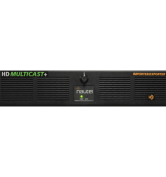Abstract
With increased saturation of the VHF band II used for FM, few frequencies are available for new radio stations in many markets. This paper describes the benefits of using the In Band On Channel (IBOC) signal in an all-digital configuration to boost the number of effective audio services in the FM band. A new method of creating an all-digital IBOC signal configuration is described. Multiple instances of the dual sideband IBOC signal are frequency shifted and added to create a multiplex of independent IBOC signals. This multiplex can then be broadcast using a single wide-band IBOC capable broadcast transmitter and antenna system with or without an FM carrier. In order to maintain a practical amplifier Peak-to-Average Power Ratio (PAPR) the multiplex must be processed by a modified PAPR reduction algorithm that factors in the frequency shift of the individual IBOC signals. Among other combinations, it is possible to combine 3 IBOC stations with an occupied bandwidth of 600 kHz and receive up to 15 audio services on HD Radio receivers available today.
This paper proposes to retain VHF band II for its intended purpose of sound broadcasting and consider the possibilities of an extended FM band including TV channel 5 and 6. A build out of the FM band maintaining existing FM services, embracing hybrid FM plus IBOC stations and introducing all digital IBOC broadcasts promises to provide a smooth digital radio transition with the end goal of improved spectral efficiency and lower transmission costs.
Index Terms—FM, IBOC, HD Radio, spectral efficiency, spec- tral planning, OFDM, QPSK, PAPR, crest factor reduction, frequency reuse, HD Multiplex, advanced RF modulation
Interleaving IBOC Signals for Digital HD Radio Multiplex by Philipp Schmid

